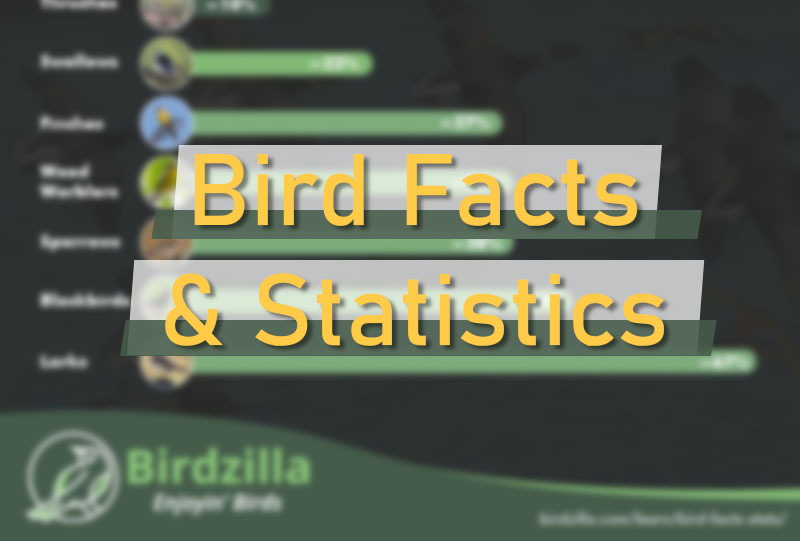
A new year is upon us, and as we begin this fresh chapter, it is important to remember our feathered friends – the birds.
They reflect the health of our planet as their well-being is intrinsically linked to the health of the ecosystem in which they live.
All of them are vital parts of our world, and their presence or absence can tell us a great deal about the state of our environment.
So, as we look forward to the year ahead, let’s explore some fascinating birds facts and statistics.
On this page
Birds have been around for about 150 million years.
Technically speaking, birds are dinosaurs since they’ve evolved from them. Their ancestors were small, feathered, meat-eating creatures from the theropod group.
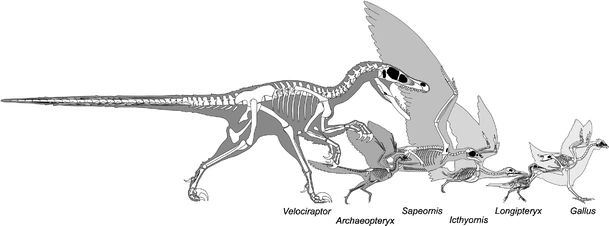
Over millions and millions of years, the original dinosaurs have adapted to their surroundings and evolved into smaller species. Source
After the disastrous change in the environment that wiped out most other species, birds were able to survive due to their small size, ability to fly, and adaptability. Over time, they evolved into thousands of different species with unique characteristics and strengths to thrive in various habitats.
The earliest known bird was the Archaeopteryx. They lived 150 million years ago, and were quite small in size, around the same size as magpies.
Nowadays, the closest bird species we have to dinosaurs is the Southern Cassowary. They’re also one of the most dangerous, as their sharp talons are four inches long and they may attack humans if provoked.
Birds are avians, not mammals
Although birds and mammals share a common ancestor – the dinosaurs – then over 300 million years of evolution has divided them so that they have clear distinguishing characteristics. Both are vertebrates, warm-blooded, and breathe air with lungs, but they differ in many ways.
Do you know: How did birds get their names?
While mammals are covered in hair, birds have feathers. Birds lay eggs, while mammals give birth to live offspring. Also, mammals have mammary glands and feed their young with milk, whereas birds don’t have mammary glands and regurgitate half-digested food for their young.
These differences in characteristics highlight how evolution has shaped birds and mammals into distinct groups with unique features.
According to these characteristics, penguins are birds since they’re covered in feathers and lay eggs. On the other hand, bats are mammals since they give birth, have fur, and have teeth.
How many bird species are there? How many are threatened?
There are 11,188 bird species in the world as of the beginning of 2023.
According to the IUCN Red List and as of the beginning of 2023, there are 11,188 bird species in the world. They are categorizes them as follows:
- 159 are extinct
- 5 are extinct in the wild
- 233 are critically endangered
- 413 are endangered
- 754 are vulnerable
- 991 are near threatened
- 8587 are of least concern
- 46 are data deficient (meaning that there’s not enough information)
While it is difficult to estimate the exact number of individual birds, it is believed that there are more than 50 billion birds in the world. Every year, new bird species are discovered, with some of the most recent ones being the Wakatobi Sunbird and Principe Scops Owl.
Related: Extinct birds – what happened to them?
Unfortunately, some bird species have also been declared extinct, such as the Po’ouli and Ivory-billed Woodpecker, although there have been recent albeit unconfirmed reports of the latter.
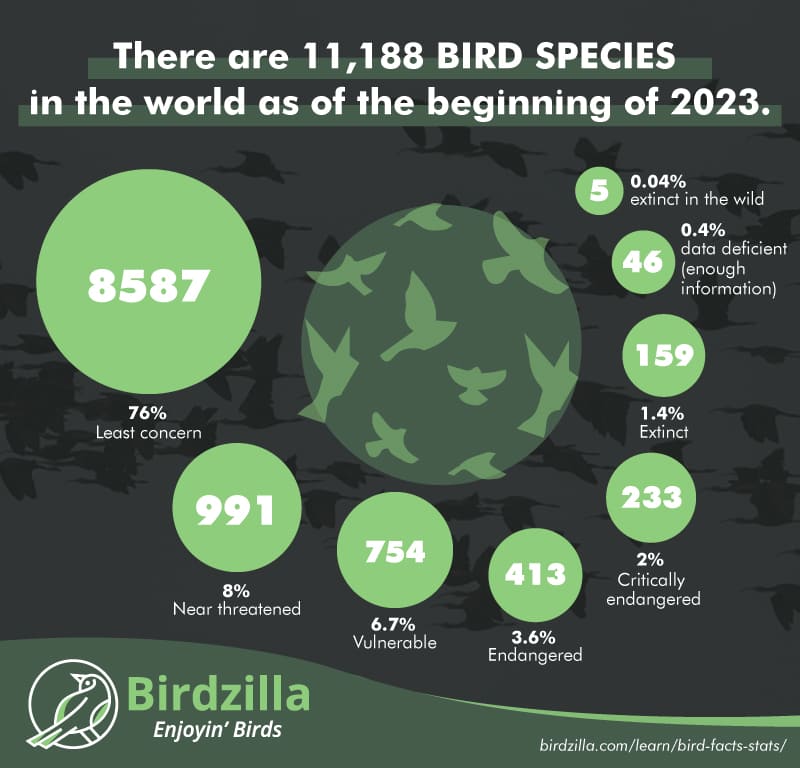
The country with the highest number of bird species is Colombia!
Countries located in warm and tropical regions tend to have the most bird species. Take Colombia for instance, which holds the record for the highest number of bird species with a whopping 1,884 species found there!
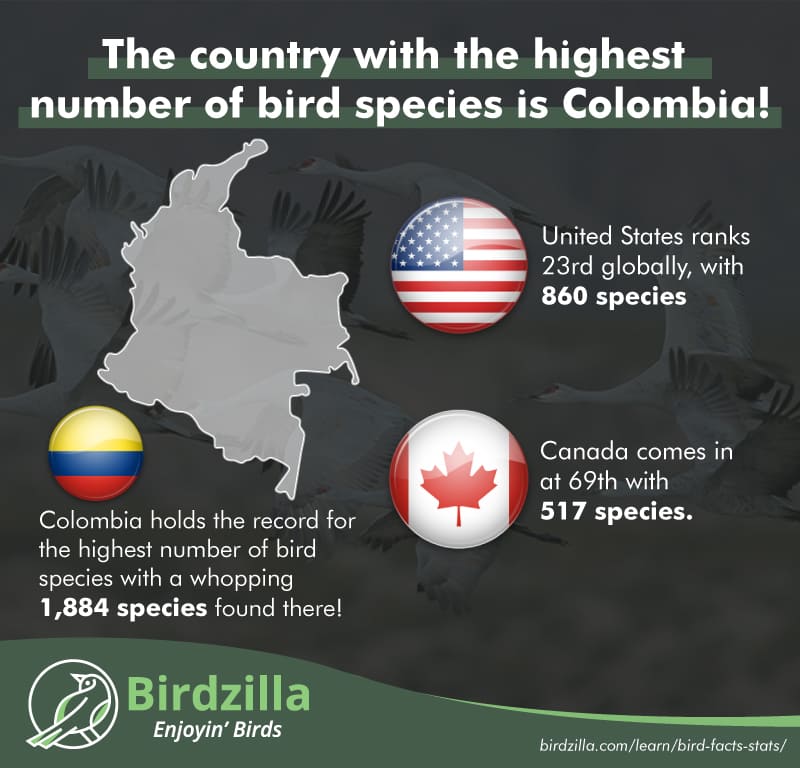
Conversely, small territories and city-states tend to have fewer species, with the Vatican City State taking the last spot on the list with zero bird species. The United States ranks 23rd globally, with 860 species, while Canada comes in at 69th with 517 species.
Chickens have the largest population amongst bird species
Overall, domestic chickens rule the world with a population of over 20 billion individuals. Although nowadays, there are several breeds of chickens, they still share the same traits. Even though chickens are everywhere today, they might not have been the first bird breed that was domesticated – geese are speculated to be the first ones!
In the wild, however, the most numerous bird species is the Red-billed Quelea, with an astounding population of 1.5 billion individuals! And when it comes to the most widespread bird species in the US, the honor goes to the American Robin.
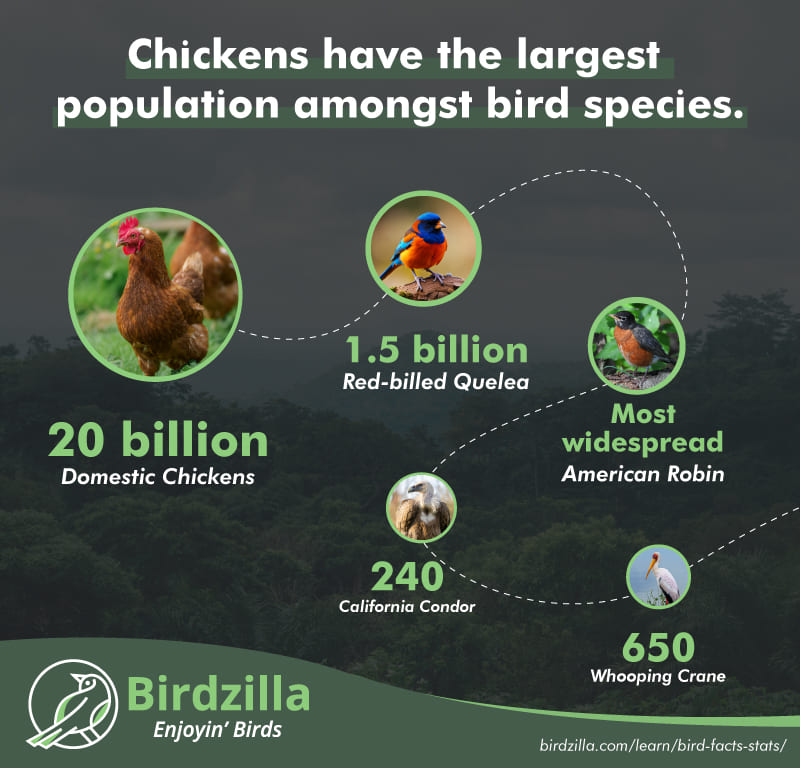
While we cannot say for certain which species is the rarest, we can bring some of the rarer ones to the spotlight. In North America, the title of the rarest bird goes to the California Condor with only 240 individuals remaining in the wild. A close second is the Whooping Crane, with a total population of 650 birds.
The biggest, the smallest, and the strongest
The bird world is full of fascinating extremes, from the massive Common Ostrich to the diminutive Bee Hummingbird – the biggest and the smallest of them all.
Some birds are known for their longevity, like Cocky Bennett the Cockatoo, who lived to the ripe old age of 120 years. Others, like the Ruby-throated Hummingbirds, have a tragically short lifespan of just 3-4 years on average.
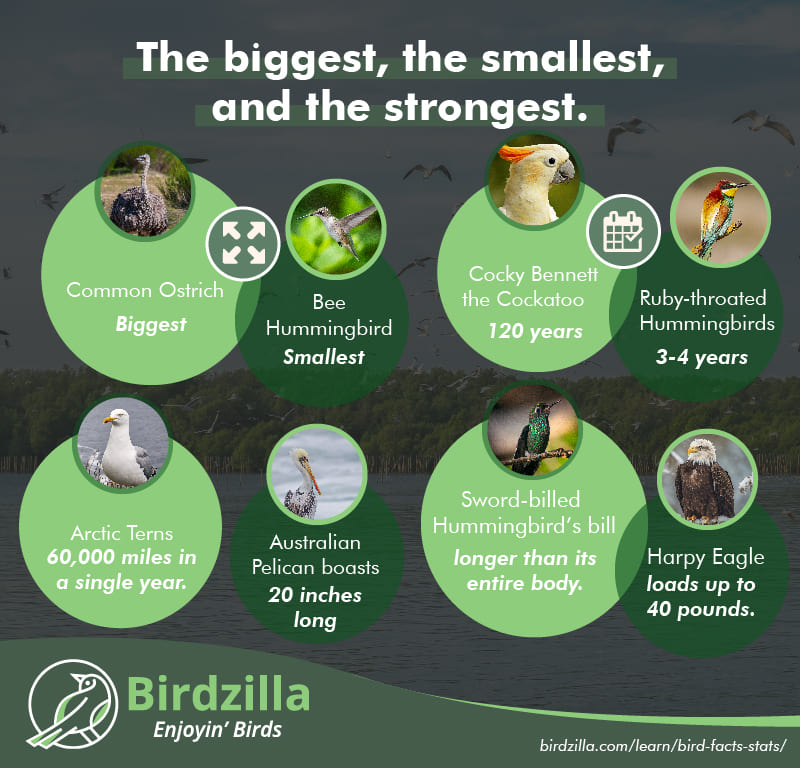
Meanwhile, Arctic Terns hold the title for longest migration, traveling up to 60,000 miles in a single year. The Australian Pelican boasts the longest bill, which measures an impressive 20 inches long, but the Sword-billed Hummingbird’s bill is even more remarkable – longer than its entire body.
Related: Bird Quotes to Cheer Up Your Day
Finally, the Harpy Eagle is a true powerhouse, capable of lifting loads up to 40 pounds. However, the biggest eagles in the world are Philippine Eagles.
Facts About How Birds Work
Birds’ eyesight is generally much better than that of other vertebrates.
Birds are known to have exceptional eyesight as they rely heavily on it for safe flight and predator detection. One of the reasons for this is that bird’s eyes are flatter than those of mammals, which allows more of their visual field to be in focus. In fact, birds have the largest eyes relative to their size in the entire animal kingdom.
Additionally, different bird species have special adaptations related to their way of life. For example, the eyes of birds of prey are geared towards visual acuity and accurate distance judgment.
Nocturnal species have fewer color detectors but can see better in the dark. Seabirds have also adapted to improve their distance vision. Birds with eyes on the sides of their heads have a wide field view, which is useful for detecting predators.
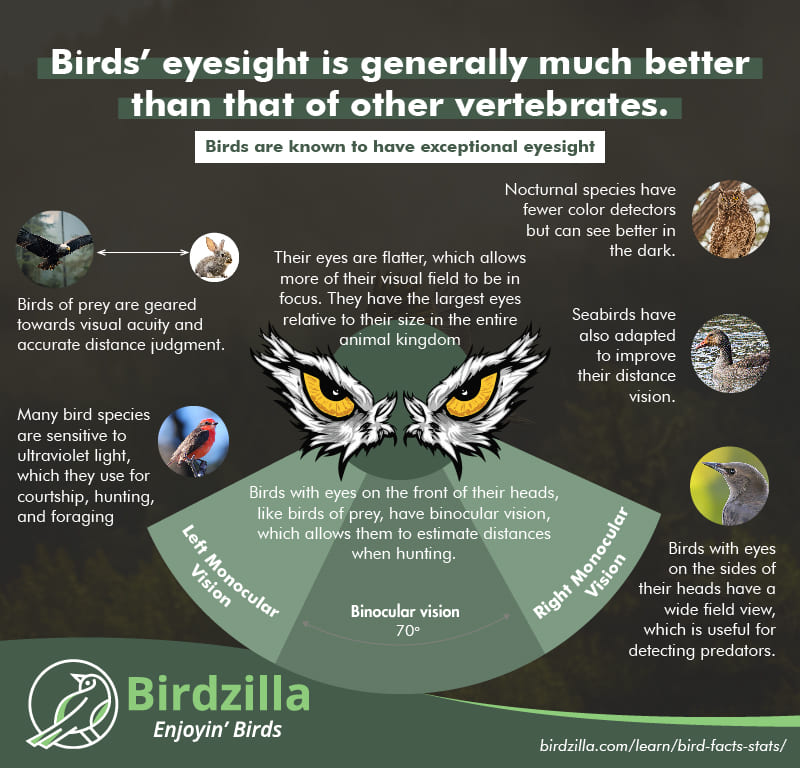
On the other hand, birds with eyes on the front of their heads, like birds of prey, have binocular vision, which allows them to estimate distances when hunting.
Furthermore, many bird species are sensitive to ultraviolet light, which they use for courtship, hunting, and foraging, and can even use to differentiate between clean and polluted water bodies. Some studies suggest that birds may “see” magnetic fields and use them for navigation during migration.
Most birds do not possess a great sense of smell
Birds are not generally known for their keen sense of smell, but there are some interesting exceptions.
Kiwis (the national birds of New Zealand), for instance, have very poor eyesight and instead rely on their sense of smell to detect prey. These unique birds are the only ones with nostrils located at the end of their long bills, allowing them to sniff out food in their habitat.
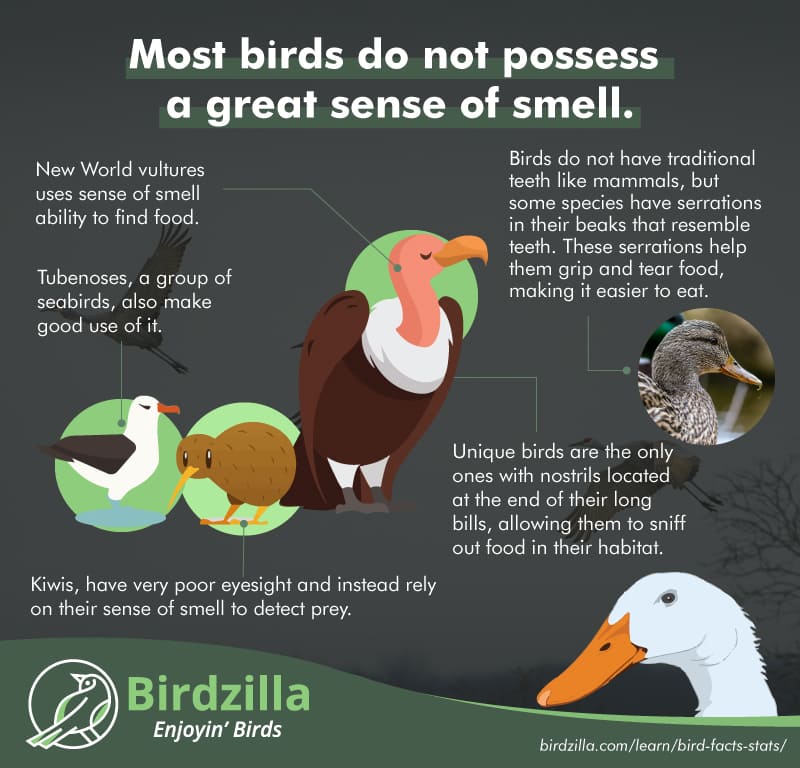
Another bird species that uses this ability to find food are New World vultures. They have been known to detect carrion from long distances using their heightened sense of smell. Tubenoses, a group of seabirds, also make good use of it.
Those who nest in burrows have developed this ability to detect prey at sea and to locate their nesting colonies.
Ouch, this bird has teeth! Or does it?
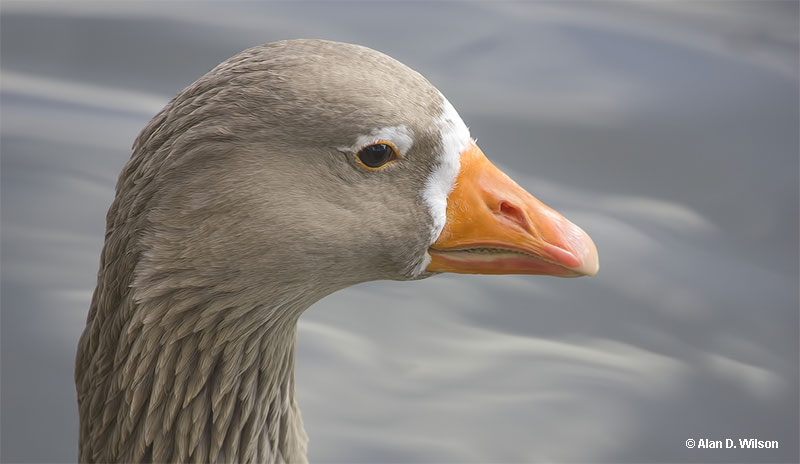
Geese have small structures resembling teeth, but these are still part of their bills. Photograph © Alan D. Wilson
If you were to ask someone whether birds have teeth, they would likely say no. However, the truth is a bit more complex.
Birds do not have traditional teeth like mammals, but some species have serrations in their beaks that resemble teeth. These serrations help them grip and tear food, making it easier to eat. This is why getting bitten by a goose tends to hurt so much.
Birds’ singing is linked to their survival
Birds are well-known for their beautiful songs and calls, which serve a variety of important purposes in their lives. Singing is a crucial tool for birds in attracting mates, communicating with one another, and warning of potential dangers such as predators.
Research has shown that birds learn to sing by imitating the songs of other birds during a critical period in their development, much like how humans learn a language. This means that the songs that birds sing are not only innate but also shaped by their environment and the songs of other birds around them.
In a sense, singing is a survival mechanism for birds, as it allows them to communicate and interact with others of their kind, forming bonds and establishing territory that are vital to their survival in the wild. This is also why caged birds, even when they are alone, will still continue to sing.
Bird Sleep Facts
Birds sleep in a variety of ways depending on their species and environment. Those exposed to predators tend to have less deep sleep than those in more protected environments.
Instead of sleeping with both brain hemispheres at the same time like humans, birds sleep with one hemisphere at a time, while keeping the other awake. This allows them to maintain a level of vigilance and react quickly to potential threats.
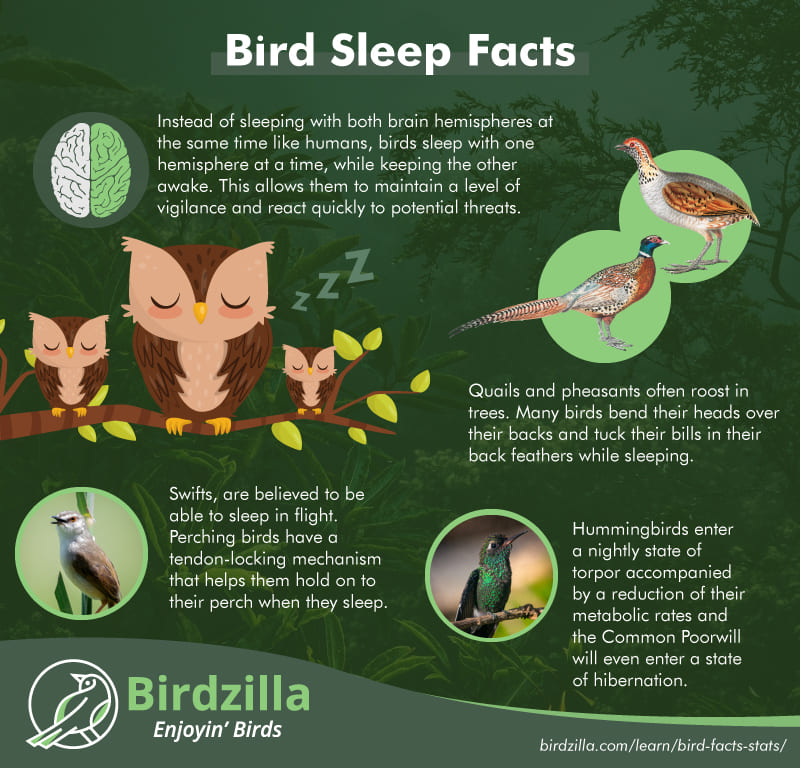
Birds often choose roosting sites with regard to thermoregulation and safety. Communal roosting is common among many species as it reduces the loss of body heat and decreases the risk of predation.
Some birds, such as swifts, are believed to be able to sleep in flight. Perching birds have a tendon-locking mechanism that helps them hold on to their perch when they sleep.
Ground birds such as quails and pheasants often roost in trees. Many birds bend their heads over their backs and tuck their bills in their back feathers while sleeping. Some hummingbirds enter a nightly state of torpor accompanied by a reduction of their metabolic rates and the Common Poorwill will even enter a state of hibernation.
Bird Flight Facts
Flight is the primary means of locomotion for most bird species and is used for searching for food and escaping from predators.
This ability easily distinguishes them from almost all other vertebrate classes.
They can fly because their wingspan and muscle strength are in balance with their body size and weight. A bird’s wings act as both wings and propellers, and they steer mainly with their tails.
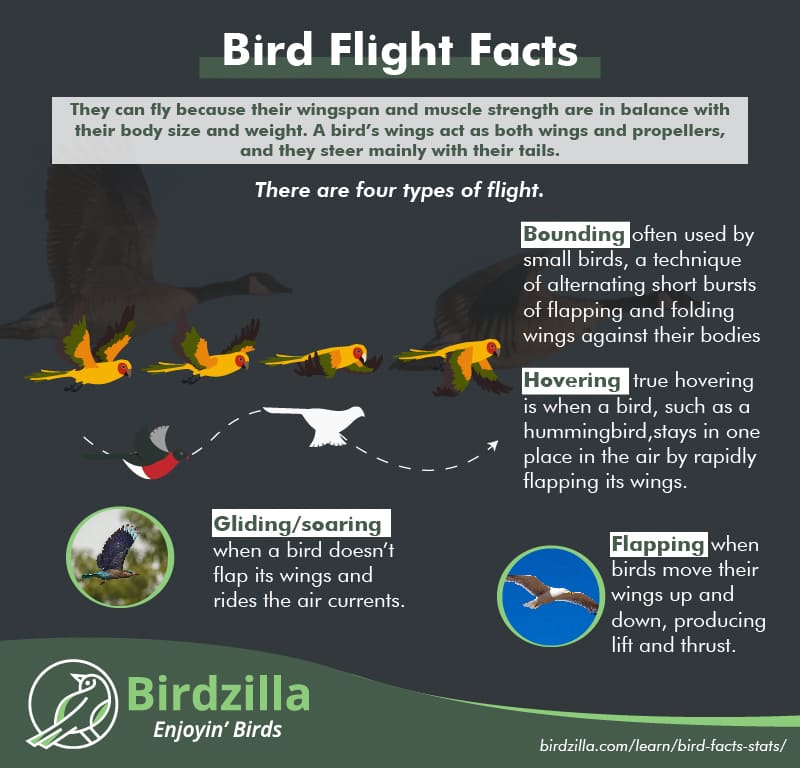
There are four types of flight.
- Gliding/soaring – when a bird doesn’t flap its wings and rides the air currents.
- Flapping – when birds move their wings up and down, producing lift and thrust.
- Bounding – often used by small birds, a technique of alternating short bursts of flapping and folding wings against their bodies.
- Hovering – true hovering is when a bird, such as a hummingbird, stays in one place in the air by rapidly flapping its wings.
Wing shape and size generally determine a bird’s flight style and performance. What makes flying even easier for birds is that they have hollow bones and air sacs.
Did you know? The Wandering Albatross has the greatest wingspan in the world, with a whopping 12.1 feet!
Some birds combine powered, flapping flight with less energy-intensive soaring flight. About 60 extant bird species are flightless, mainly those living on isolated islands since they lack ground predators.
Most songbirds have to fly at least 11 mph just to stay in the air!
Flying is a challenging feat for birds, especially for smaller birds with smaller wings since they have to flap faster. For example, hummingbirds beat their wings 10-53 times per second.
Related: Hummingbird Facts
The record belongs to an Amethyst Wood-star Hummingbird with 80 beats per second. However, size and weight also play a role. It was calculated that an ostrich would have to take off and maintain a pace of 100 mph just to stay in the air!
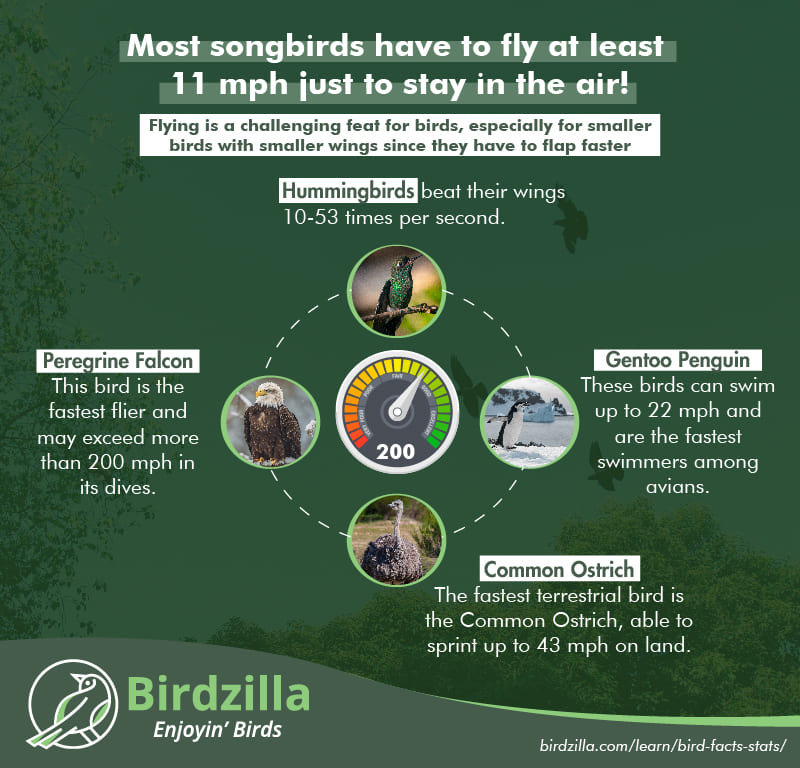
Speaking of speed, some birds are capable of achieving incredibly high speeds. Here are some of the fastest birds on the planet!
- Peregrine Falcon – This flyer is the fastest bird and may exceed more than 200 mph in its dives.
- Common Ostrich – The fastest terrestrial bird is the Common Ostrich, able to sprint up to 43 mph on land.
- Gentoo Penguin – These birds can swim up to 22 mph and are the fastest swimmers among avians. That’s vital, considering they are flightless and move on the ground by waddling.
The primary driving force behind migration is food availability.
Bird migration is a remarkable phenomenon that involves the regular seasonal journey of many bird species, often spanning long distances along designated flyways, between their breeding and wintering grounds. Migration, although essential for survival, comes with significant risks such as predation and mortality, including hunting by humans.
The primary driving force behind migration is the pursuit of food, as birds move to areas where resources are more abundant. Most migratory activity occurs in the northern hemisphere and is influenced by changes in day length, which act as a crucial cue for timing the migration.
Birds possess remarkable navigational abilities, relying on celestial cues from the sun and stars, the earth’s magnetic field, and mental maps to find their way.
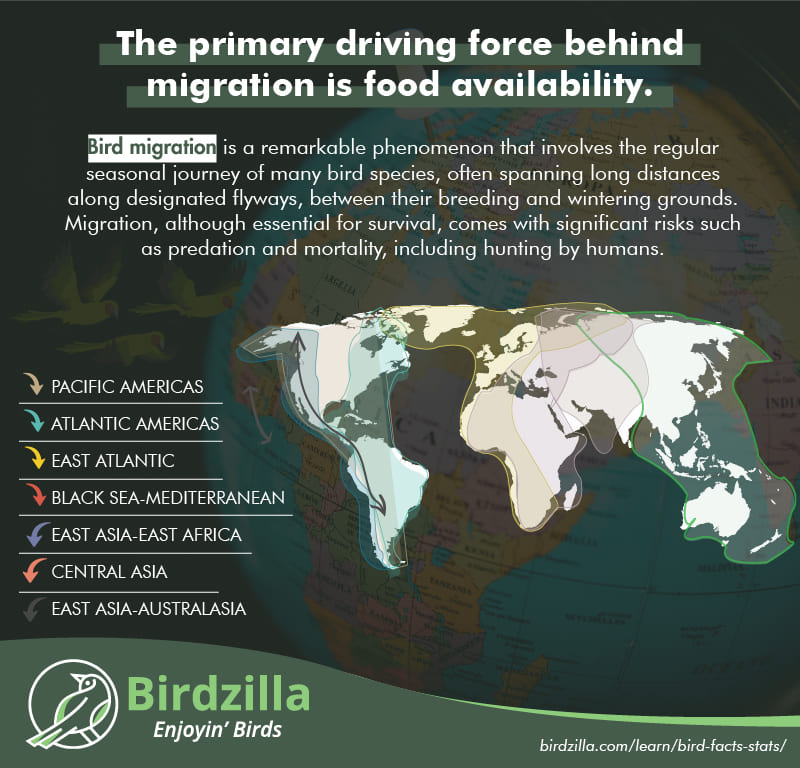
Approximately 1,800 of the world’s bird species undertake long-distance migrations.
Many birds migrate in flocks, which not only reduces the energy cost for larger birds but also allows them to fly faster and conserve precious resources. For example, Canada Geese that fly in V-formation conserve around 10-35% of energy compared to what they would need to fly solo. Dunlins and Red Knots fly 3 mph faster when flying in flocks.
And fascinatingly, migration is not solely limited to birds capable of flying! Penguins, for instance, undertake migration by swimming, while Dusky Grouse accomplishes altitudinal migration primarily by walking.
Bird Nest and Egg Facts
The female primarily builds the nest in most bird species.
Bird nests are nature’s architectural marvels, delicate yet resilient, providing a sanctuary and shelter for them to hatch their eggs and raise their young. They’re most often crafted using twigs, grass, feathers, moss, mud, spider silk, and bark.
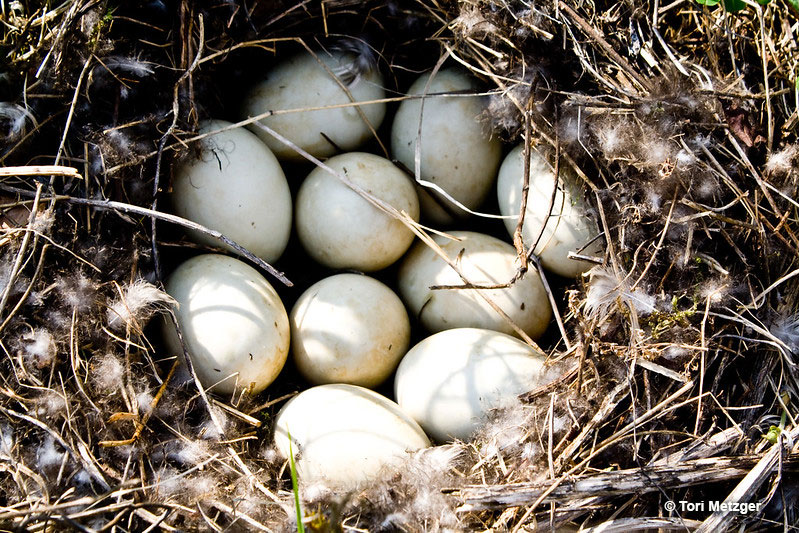
Nests are important to birds – especially for growing the young. © Tori Metzger
Bird nests can be found in various places. Some nests are built on tree branches or tree crotches, while others snugly fit within tree hollows, concealed from prying eyes. Most kingfisher species nest in burrows they dig themselves. Some species, like Monk Parakeets, nest colonially and intertwine multiple nests into a huge tandem.
- Largest bird nest – located near St Petersburg, Florida, the largest nest was built by Bald Eagles. It measured 9 ft 6 in wide and 20 ft tall and was estimated to weigh around or more than 4,409 lb.
- Smallest bird nest – constructed by hummingbirds. Vervain Hummingbird nests are about half the size of a walnut shell, whereas Bee Hummingbird nests are about thimble-sized.
- Largest incubation mound – measuring 15 ft in height, 35 ft across, and estimated to weigh around 661,386 pounds, this incubation mound was built by the Mallee Fowl.
- Longest nest burrow – the bird behind the longest burrow, measuring 26 ft long is the Rhinoceros Auklet.
- Highest tree nest – Marbled Murrelets build their nests as high as 148 ft.
The default color of bird eggs is white
While white is the default color of most bird eggs, some species, mainly passerines, produce pigmented eggs in hues of green, blue, red, and brown. These colors come from pigments called biliverdin, protoporphyrin, and zinc chelate.
Camouflage plays an important role in the coloration of eggs. For instance, birds that nest out in the open, such as ground-nesting birds and some parasitic cuckoos lay eggs that match the color of their environment or host.
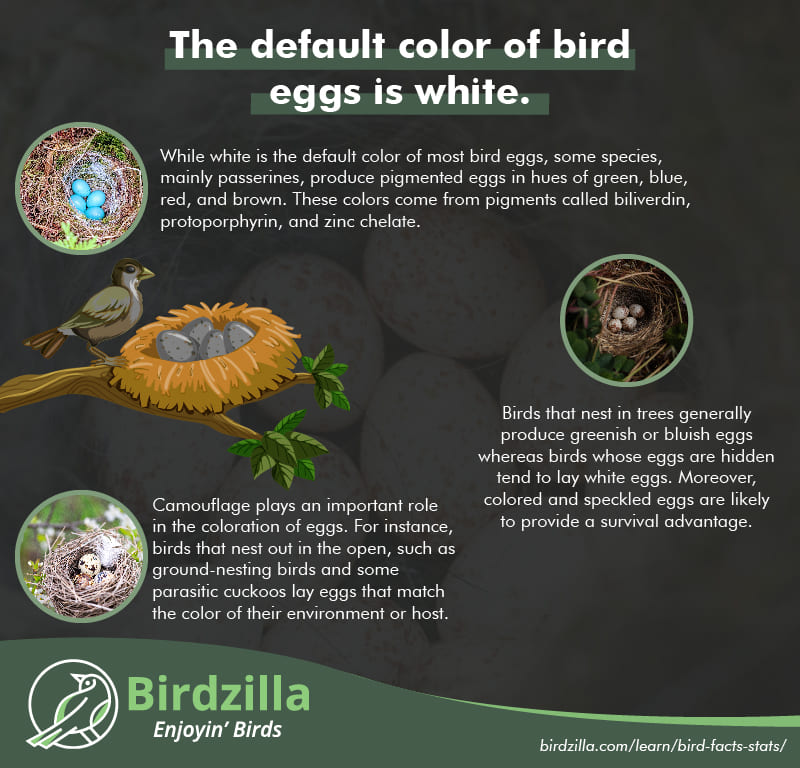
Birds that nest in trees generally produce greenish or bluish eggs whereas birds whose eggs are hidden tend to lay white eggs. Moreover, colored and speckled eggs are likely to provide a survival advantage.
A hypothesis suggests that color has a thermoregulatory benefit. Darker-colored eggs heat up faster and retain the warmth longer than white eggs. Another hypothesis proposes that pigmented spots and speckles reinforce weak spots in the eggshell, while yet another hypothesis suggests that different colors serve as a signal of fitness to potential mates.
Interestingly, the color of the eggs is inherited only from the mother, and later eggs in a clutch tend to be more spotted as the female’s store of calcium is depleted.
Common Ostriches lay the largest eggs.
Generally, birds lay eggs that are proportionate to their size. The smallest bird egg belongs to the Bee Hummingbird. Their eggs are about the size of a coffee bean. The largest bird eggs are laid by ostriches, which measure around 6 inches long and 5 inches wide and weigh 3 pounds.
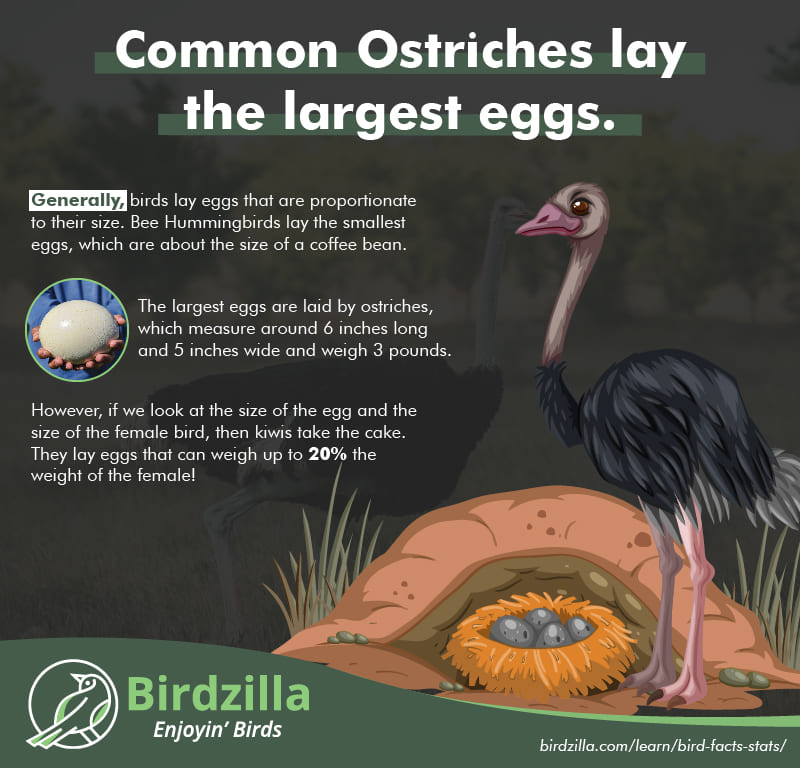
However, if we look at the size of the egg and the size of the female bird, then Kiwis take the cake. They lay eggs that can weigh up to 20% the weight of the female!
Facts About The Most Popular Birds
Facts About Dodo
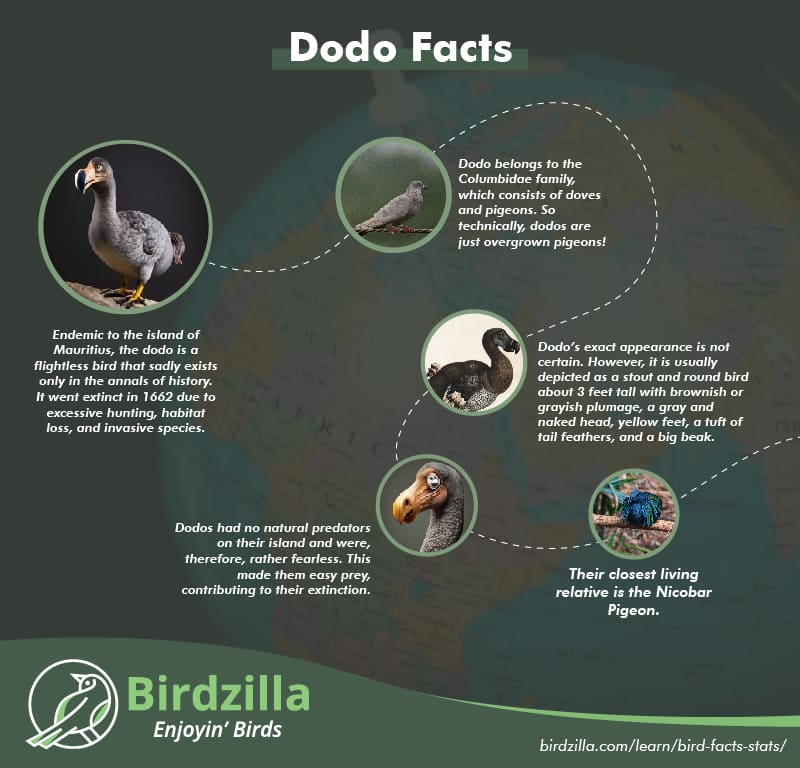
- Endemic to the island of Mauritius, the dodo is a flightless bird that sadly exists only in the annals of history. It went extinct in 1662 due to excessive hunting, habitat loss, and invasive species.
- Dodo belongs to the Columbidae family, which consists of doves and pigeons. So technically, dodos are just overgrown pigeons!
- Dodo’s exact appearance is not certain since the only things we have to go on are paintings, drawings, written accounts, and subfossils. However, it is usually depicted as a stout and round bird about 3 feet tall with brownish or grayish plumage, a gray and naked head, yellow feet, a tuft of tail feathers, and a big beak.
- Dodos had no natural predators on their island and were, therefore, rather fearless. This made them easy prey, contributing to their extinction.
- Their closest living relative is the Nicobar Pigeon.
Facts About Hummingbirds
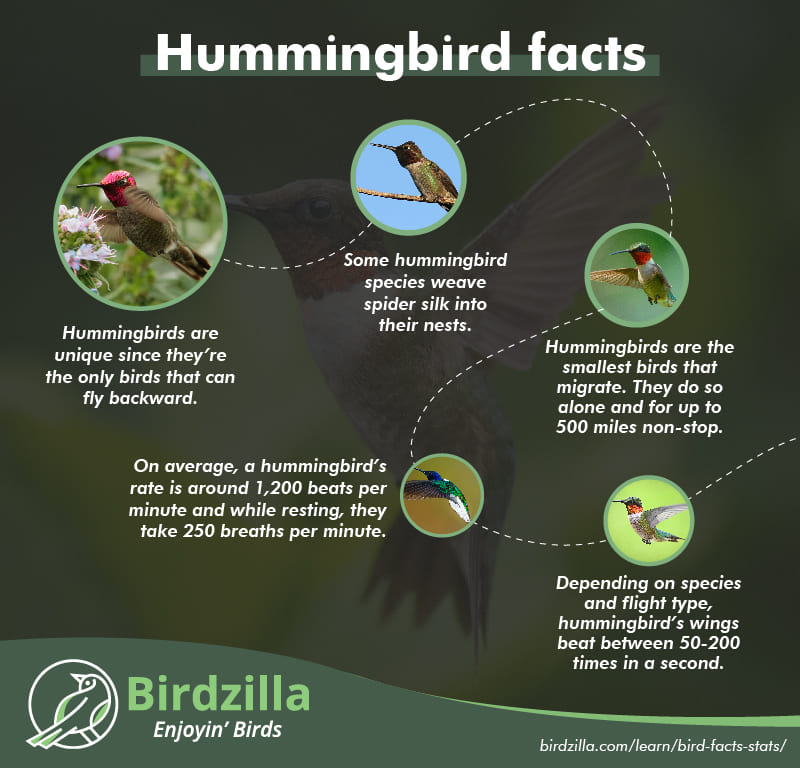
- Hummingbirds are unique since they’re the only birds that can fly backward.
- Some hummingbird species weave spider silk into their nests so that it can expand as their offspring hatch and grow.
- Hummingbirds are the smallest birds that migrate. They do so alone and for up to 500 miles non-stop. However, most species are non-migratory.
- On average, a hummingbird’s rate is around 1,200 beats per minute and while resting, they take 250 breaths per minute.
- Depending on species and flight type, a hummingbird’s wings beat between 50-200 times in a second.
- Hummingbirds have been around for thousands of years. Nazca Lines in Peru are a true testament to their long history.
Facts about Blue Jays
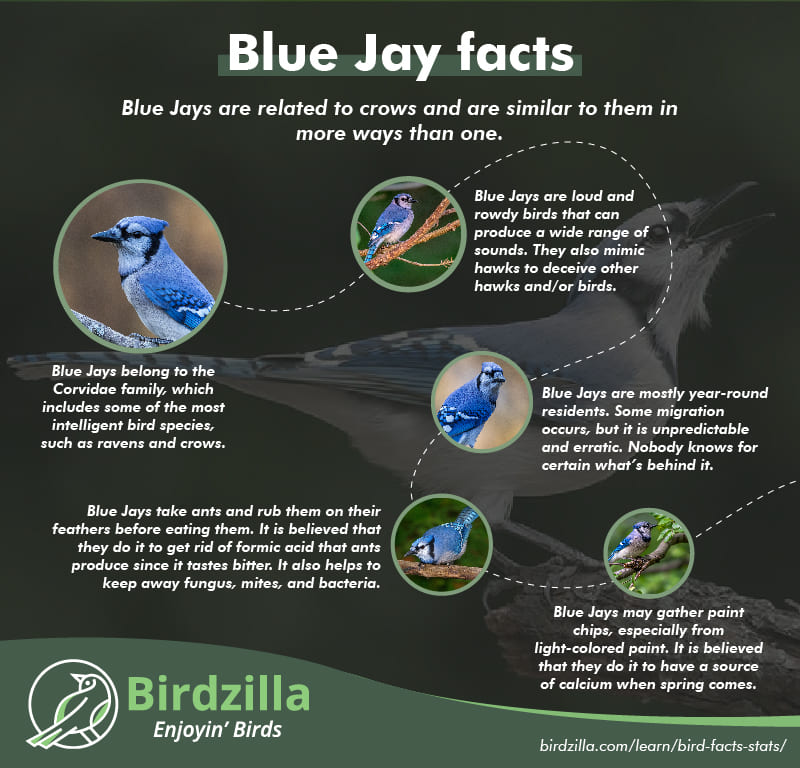
- Blue Jays belong to the Corvidae family, which includes some of the most intelligent bird species, such as ravens and crows (some Corvids can even mimic human speech and sounds!). This species is also very intelligent. For example, they’re able to differentiate Brown-headed Cowbird eggs from their own, and in captivity, they’re even being seen to use tools!
- Blue Jays are loud and rowdy birds that can produce a wide range of sounds. They also mimic hawks to deceive other hawks and/or birds.
- Blue Jays are mostly year-round residents. Some migration occurs, but it is unpredictable and erratic. Nobody knows for certain what’s behind it.
- Blue Jays take ants and rub them on their feathers before eating them. It is believed that they do it to get rid of formic acid that ants produce since it tastes bitter. It also helps to keep away fungus, mites, and bacteria.
- Blue Jays may gather paint chips, especially from light-colored paint. It is believed that they do it to have a source of calcium when spring comes. If you have Blue Jays chipping away at paint, try providing another source of calcium, such as crushed eggshells.
Facts About Cardinals
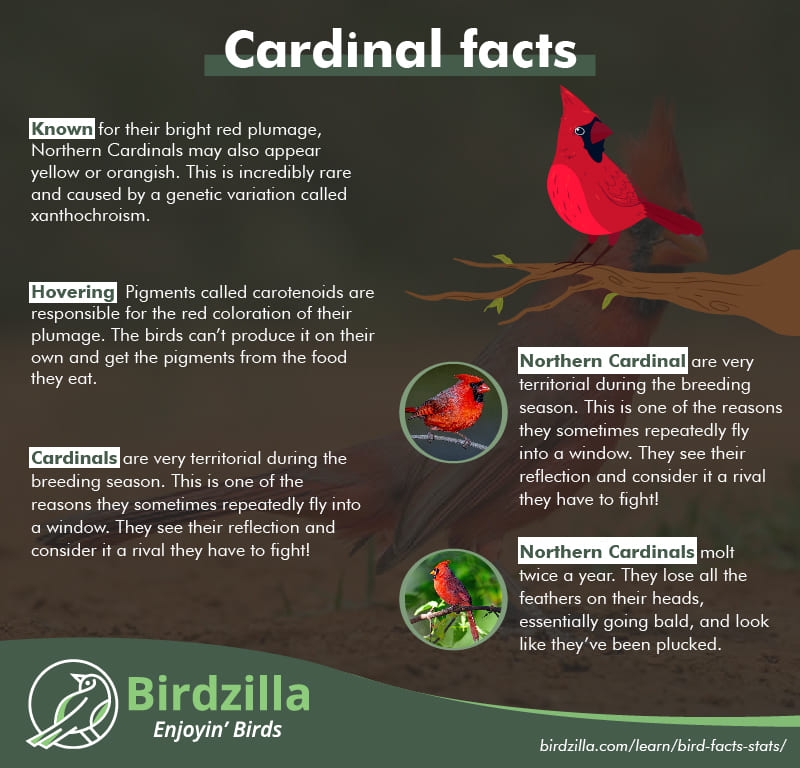
- Known for their bright red plumage, Northern Cardinals may also appear yellow or orangish. This is incredibly rare and caused by a genetic variation called xanthochroism. Leucism also occurs within this species – that’s how you may even meet a white cardinal!
- Pigments called carotenoids are responsible for the red coloration of their plumage. The birds can’t produce it on their own and get the pigments from the food they eat.
- Northern Cardinal is a popular bird. They’re the state bird of seven US States and a mascot for many sports teams and colleges.
- Cardinals are very territorial during the breeding season. This is one of the reasons they sometimes repeatedly fly into a window. They see their reflection and consider it a rival they have to fight!
- Northern Cardinals molt twice a year. They lose all the feathers on their heads, essentially going bald, and look like they’ve been plucked.
Miscellaneous Interesting Bird Facts You Might Want To Know
The Most Popular US State Bird is the Northern Cardinal
In the United States, each state boasts a unique symbol that represents its heritage and natural beauty. Along with flags, seals, and flowers, all states have designated a state bird – an official avian ambassador that represents the state’s identity. We’ve brought out the top three most popular picks.
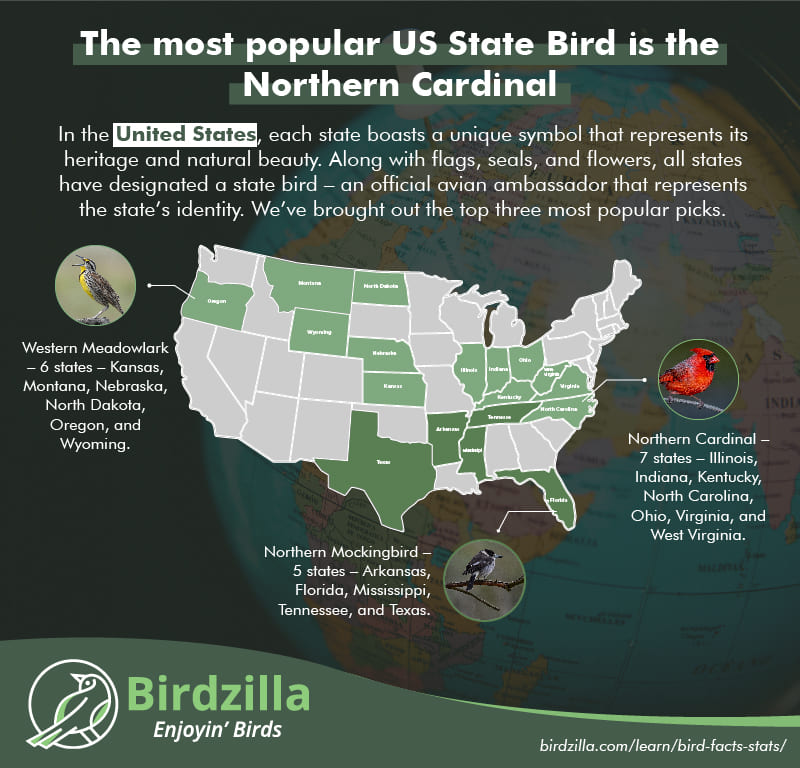
- Northern Cardinal – 7 states – Illinois, Indiana, Kentucky, North Carolina, Ohio, Virginia, and West Virginia.
- Western Meadowlark – 6 states – Kansas, Montana, Nebraska, North Dakota, Oregon, and Wyoming.
- Northern Mockingbird – 5 states – Arkansas, Florida, Mississippi, Tennessee, and Texas.
What Does It Mean When You See a Bird of a Certain Color?
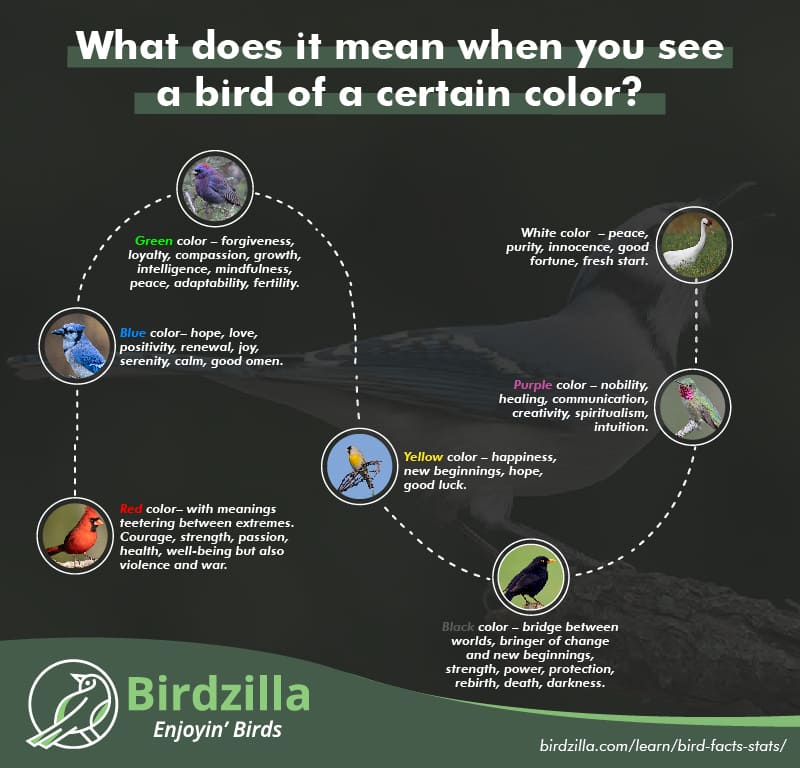
Through ages, cultures, and locations, different colored birds have symbolized different things. It even differs from species to species and in what context you saw them.
Interestingly, some birds get their colors from food. For example, flamingos get their flamboyant orange pigment from their food – by eating foods rich in beta carotene.
We’ve compiled a general guide as to what some of the more common colors symbolize.
- Red – color with meanings teetering between extremes. Courage, strength, passion, health, well-being, but also violence and war.
- Blue – hope, love, positivity, renewal, joy, serenity, calm, good omen.
- Green – forgiveness, loyalty, compassion, growth, intelligence, mindfulness, peace, adaptability, fertility.
- Yellow – happiness, new beginnings, hope, good luck.
- Purple – nobility, healing, communication, creativity, spiritualism, intuition.
- Black – bridge between worlds, bringer of change and new beginnings, strength, power, protection, rebirth, death, darkness.
- White – peace, purity, innocence, good fortune, fresh start.
Statistics
Global Bird Population Trend Shows a Decline
The IUCN Red List provides a comprehensive overview of the status of 11,188 species worldwide.
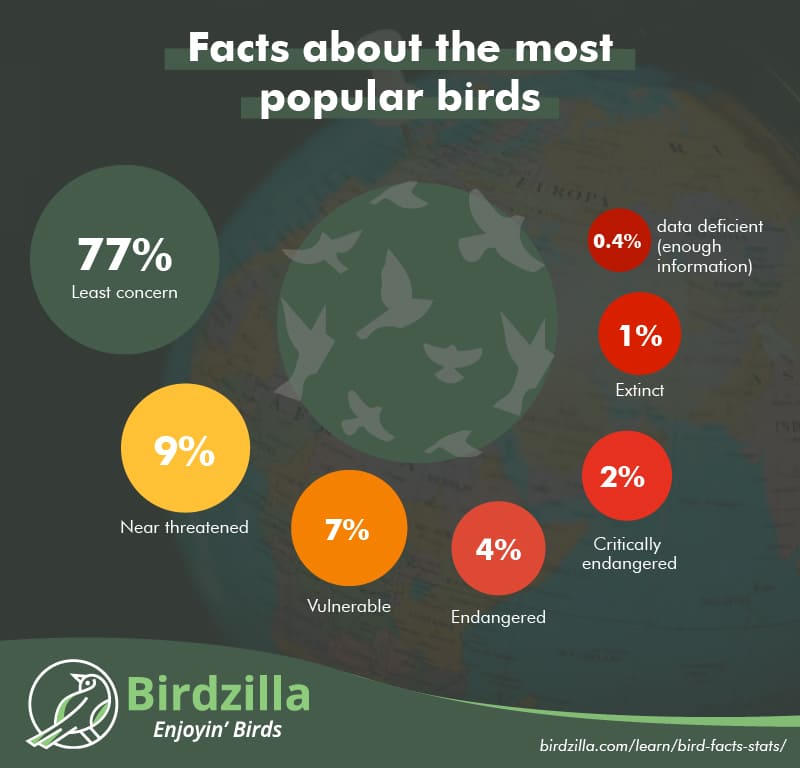
- 77% are categorized as least concern
- 9% as near threatened
- 7% as vulnerable
- 4% as endangered
- 2% as critically endangered
- 1% as extinct
- 0.4% as data deficient
Within the bird species all around the world, 49% are experiencing declining populations, highlighting a significant conservation challenge. In contrast, 38% of bird species have stable populations, while 6% are showing positive growth, and 6% have unknown trends.
These declines are not limited to rare or endangered species but also impact common and widespread species, underscoring the potential ecosystem-wide consequences.
Encouragingly, conservation efforts have yielded some positive results. Since 1988, 93 bird species have been downlisted to lower threat categories due to genuine improvements in their status.
Although a small victory, it is estimated that only one bird species goes extinct every 3-4 years thanks to conservation efforts.
However, the flip side reveals that 436 species have been moved to higher threat categories due to a genuine deterioration in their status.
Tragically, at least 184 bird species are confirmed or suspected to have gone extinct since 1500. The majority of these extinctions have been among endemic island species, emphasizing the vulnerability of isolated populations.
The Bird Population in North America Is In Decline As Well
North America is home to approximately 2059 bird species.
However, alarming trends indicate a net loss of 2.9 billion birds, amounting to a 29% decline since 1970.
This decline has had a particularly severe impact on migratory bird species, with a staggering loss of 2.5 billion birds across 419 species. Species associated with grasslands have also experienced significant declines, with 700 million birds across 31 species.
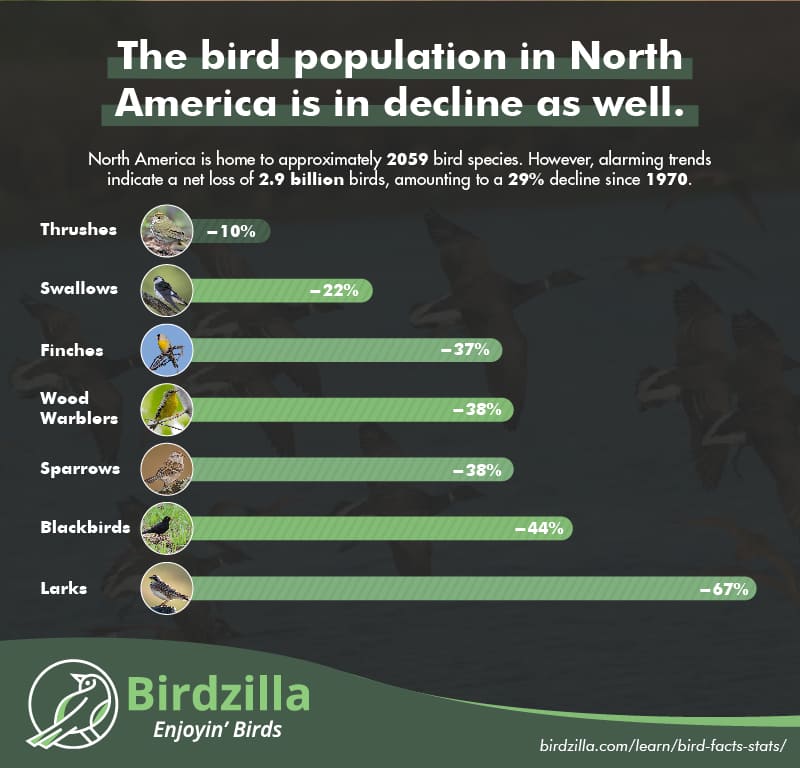
Declines in populations have been observed in other specific ecological niches as well. Aerial insectivores have experienced a striking 40% decline from 1966 to 2013.
Grassland specialists have suffered a 42% decline from 1968 to 2018, while aridland specialists have seen a 37% decline during the same period. Forest specialists have experienced a comparatively lower decline of 14% from 1968 to 2018.
Most Significant Threats Are Almost Exclusively Caused by Humans
The vast majority of threats faced by bird species worldwide can be attributed to human activities, either directly or indirectly. Some of the most significant threats impacting globally threatened bird species include:
- agricultural expansion and intensification (affecting 73% of the threatened species)
- logging (50%)
- while invasive and other problematic species (40%)
- hunting (38%)
These activities impact the habitats, reproduction, and survivability of birds as well. Habitat conversion and degradation are major concerns, affecting a striking 95% of species, and direct mortality poses a risk to 61% of them.
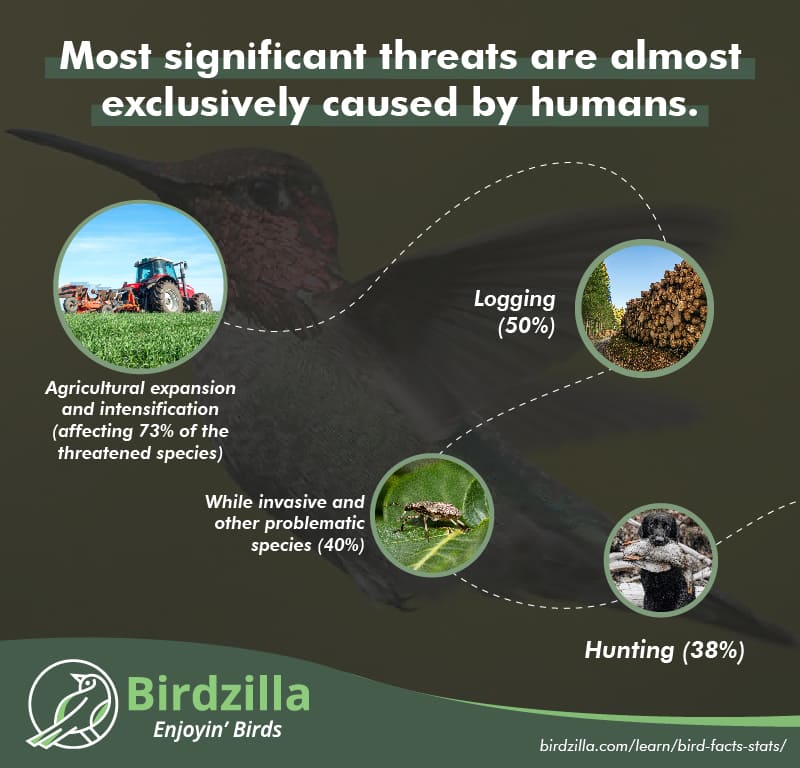
Reduced reproductive success is a concern for 36% of species, while increased competition affects 10%. It’s worth noting that most species, around 90%, are affected by more than one threat, with many threats being interrelated. Climate change poses particular concern for 34% of species.
Furthermore, invasive alien species have played a significant role in approximately 46% of all known bird extinctions. The introduction of these species into new habitats has had devastating consequences for vulnerable bird populations.
To ensure the survival of threatened bird species, targeted recovery actions are needed. Currently, 52% of these species require specific conservation efforts tailored to their unique circumstances, highlighting the urgency and importance of conservation initiatives.
